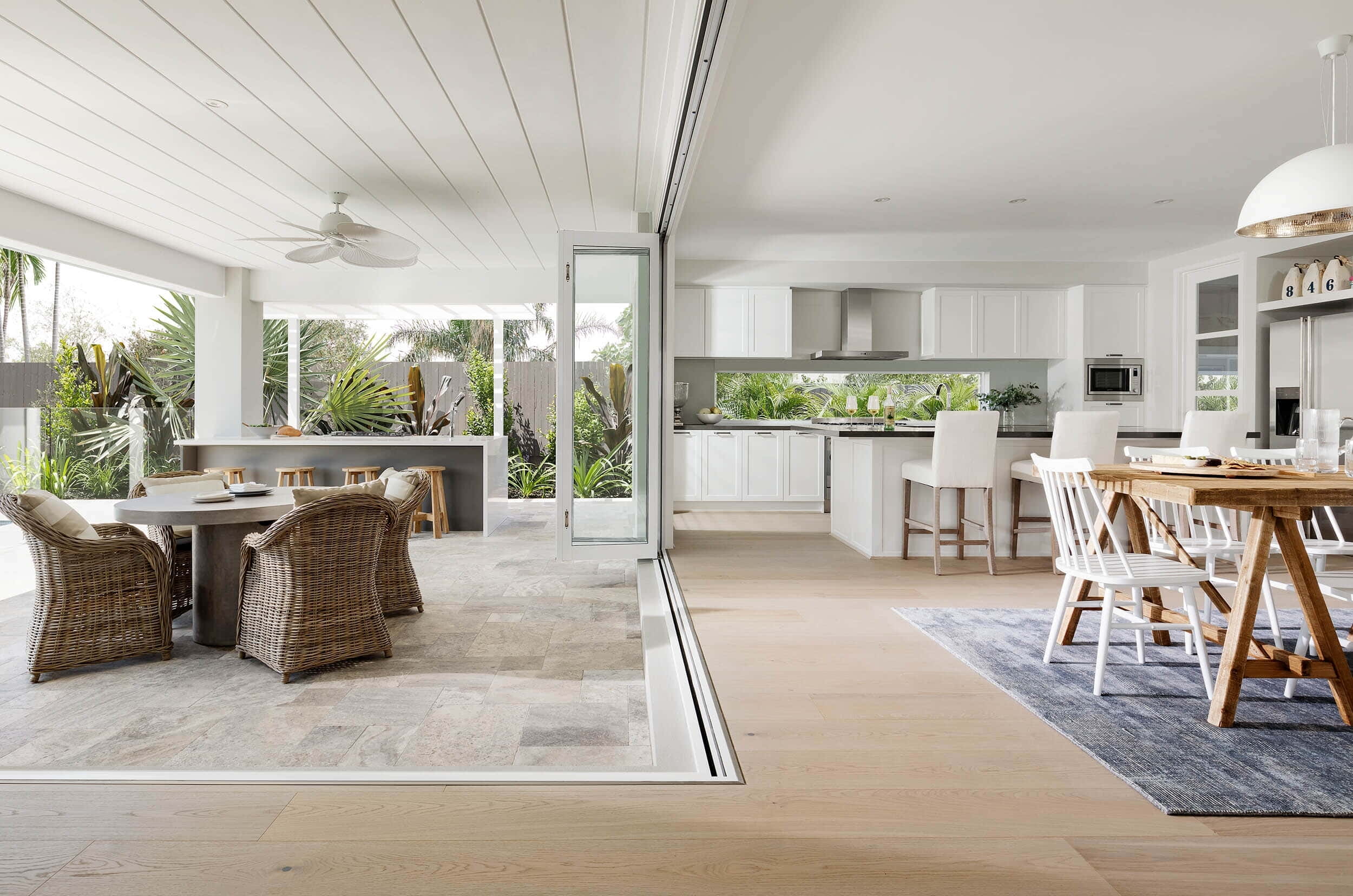Love your neighbourhood but not your house?
A knock down rebuild project could be the perfect answer! Knocking down your old home and rebuilding with Plantation Homes means you can achieve a modern, 7-star energy efficient, airy, open-planned home that embraces the Queensland climate and lifestyle.
Or you may have just bought an older or smaller home in a prime location with the intention to knock it down and build your dream home. Or perhaps you have simply outgrown your family home and are weighing up your options.
A knock down rebuild lets you replace an outdated home with a modern design that suits your lifestyle - think a private master suite with an ensuite and walk-in wardrobe, extra bedrooms, an entertainer’s kitchen with a butler’s pantry, and plenty of leisure space for the whole family. Goodbye, cramped 1950s floorplan—hello, contemporary living!
A knock down rebuild solution will appeal if:
✔ You’ve always dreamed of building a new home and don’t want to compromise on your vision
✔ Your current home is outdated or you’ve bought an older home with the intention of rebuilding
✔ You love the area, want to stay near your favourite café and keep the kids at their school or start them in a great local one
✔ You want to save stamp duty costs and real estate agent fees (who doesn’t?)
Brisbane knockdown rebuild specialists
As Brisbane's knock down rebuild specialists, Plantation Homes brings experience and expertise to guide you through every step of your knockdown and rebuild journey.
Our standard inclusions are what others call upgrades - so you get more luxury, style, and value without the extra cost. With flexible home designs and structural options, we make it easy to create a home that perfectly suits your lifestyle and block.
Whether it’s your first knock down rebuild or you’re a seasoned pro, our straightforward process ensures a smooth experience from demolish and rebuild to moving in.
To get your knock down rebuild project started, we’ll assess your block and assist you to choose the best floorplan and design to suit you perfectly.
For more information or to speak to a knock down rebuild expert, contact us today!

Why choose Plantation Homes for your knock down rebuild project?
A knock down rebuild isn’t just about rebuilding your home, it’s about creating a brand new future in a location you love. From the initial site inspection to choosing the perfect colours and designs, every step is about creating a home you’ll love for years to come. We take care of building permits and manage the construction journey for your demolish and rebuild so you can relax knowing everything is in expert hands.
Luxury homes without the custom price
Dreaming of a luxurious modern home without the custom build price tag? Achieve a brand new 50-square home with better inclusions - more of what you want at no extra cost. And you'll know how much your home will cost up front with our published home prices.
Transparent process
Our streamlined process ensures demolition, council approvals and permits are completed before you sign your contract. This means you lock in your final price upfront, avoiding the mid-construction cost variations applied by some new home builders.
Dedicated contact for each stage
When you start a knockdown rebuild project with us, you'll have one point of contact for each stage of the project. You'll always have someone to answer your questions and keep you updated on progress.
Guarantees that stand the test of time
Built to last, every Plantation home comes with a 50 year structural guarantee. We confidently and proudly stand by our work for being well above and beyond the industry standard.
Build with confidence
Plantation Homes is backed by a $7 billion parent company, the 330-year-old Sumitomo Forestry Group. This means that no matter what happens, we will finish your home… so you can build with us with absolute confidence!
Where we knock down and rebuild
As the knock down and rebuild specialists in Brisbane, the Gold Coast and the Sunshine Coast, we cover the entire south east coast of Queensland. Our team has excellent knowledge of the knock down rebuild requirements, rules and overlays for the various local council areas.
Plantation Homes knockdown rebuild specialist Paul Pereira says prime locations for knock down rebuilds include built up inner city areas and those with access to quality schools and public transport.
"The beauty of knock down rebuild projects is that you can build your dream home on a larger block, close to across established local amenities,” he says.
“The Gold Coast is a key region for knock down rebuild projects, due to a scarcity of available land and many established homes being older in style. As the CBD of the Gold Coast, Southport is particularly attractive for people seeking modern homes in a prime location."
"South Brisbane and North Brisbane, Mount Gravatt, Sunnybank, Underwood, Carindale and the Sunshine Coast coastal fringes are also popular locations for knock down rebuilds as families seek to retain their location but upgrade their homes to suit their needs.”

Our top knock down rebuild home house plans and designs
A knock down rebuild lets you stay where you love while upgrading to a stunning, energy-efficient home with Plantation Homes' signature style, premium inclusions, and cutting-edge design.
Our most popular knock down rebuild house designs are distinguished by their unrivalled Reserve inclusions and design features including resort-inspired master suites, functional living spaces, private ensuites for all bedrooms, striking voids and the adaptability of reverse floorplans.
Plantation Homes Rochedale knock down rebuild specialist Archie Nguyen says the Trinity boasted the most popular features of a knock down rebuild floorplan and was ideal for blocks with limited depth.
"The layout celebrates the quintessential Queensland lifestyle with multiple leisure areas to relax and unwind, a breezy alfresco area perfect for entertaining, an extensive master retreat with dressing room and ensuite, open plan kitchen with butler's pantry and a study or guest bedroom," he says.
Other designs that are popular with those looking to knock down and rebuild include:
- Modena: A smart design that makes the most of every bit of space. A versatile family home with standout features, it's no surprise this has become one of our most appealing knock down and rebuild options.e’re talking a stunning grand staircase, huge double dressing and ensuite in the master, walk-in robes for every bedroom (no more wardrobe wars!), linen cupboards on both floors and an expansive kitchen with butler’s pantry. You can walk through the Modena 389-D42 on display in Labrador.
- Valletta: Featuring a luxurious guest suite on the ground floor with a full ensuite and dressing room, the Valletta isp erfect for large families and multigenerational living, this design boasts a luxurious guest suite with ensuite and dressing room, plus multiple leisure zones and a spacious theatre. You can expeirience the Valletta 401-D43 in person at our Labrador Display Centre.
- Panama: Redefining what’s possible in a single storey home, with five versatile floorplan options, making it the style of choice for single storey knockdown rebuild projects. Anchored by a gourmet kitchen and open plan living area and featuring a master suite with ensuite and dressing room to the rear of the home, the Panama is perfect all types of families.


